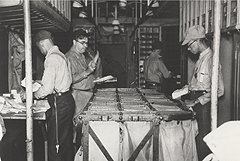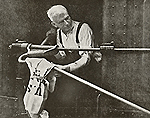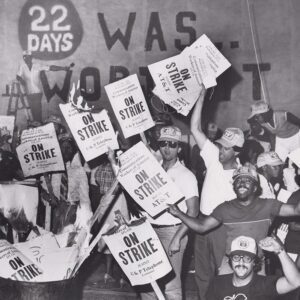August 31, 2005
Not Always a Smooth Ride
(This article was first published in the September/October 2005 issue of The American Postal Worker magazine.)
Mail transportation took the obvious route when the Continental Congress founded our nation’s postal system in 1775. The horse and rider — and maybe the occasional “buggy” — were the main features of the system for decades.

The first big change in postal transportation began nearly six decades after the Second Continental Congress put Benjamin Franklin in charge of the “Constitutional Post.” With several commercial railroad ventures getting under way, U.S. mail rode the rails for the first time in 1832. From time to time, the postal department tried shipping via stagecoaches, subcontracting to “Pony Express” relay routes, steamships, and even hot air balloons and pneumatic tubes. However, for much of the system’s history, most of the mail was moved by rail. And the postal clerks who handled it went along for what was a difficult and often dangerous ride.
U.S. Railway Mail Service
U.S. mail shipment by rail began soon after steam-powered locomotives made it possible for people and freight to move quickly through the young nation’s eastern cities.
Railway shipment greatly sped up the mail and increased the dependability and efficiency of the mail system. In 1826, mail shipped by stagecoach from Boston to Washington, DC, took eight to 10 days. Mail shipped by rail along the same route 20 years later could get there in less than a day.
For the first three decades of the Railway Mail Service, mail sacks simply were shipped by train — no sorting took place on board. Processing and distribution typically was done at facilities far removed from the new transportation network.
During the Civil War, however, the Post Office Department began assigning clerks to sort and distribute mail as trains moved between stations. After the war, as the rail network raced westward to new states and territories, much more of the nation’s mail was gradually processed in a growing fleet of Railway Mail Service cars.
What began as an experiment proved so successful that the Post Office began realigning its network to take full advantage of the rails. By the early 1900s, it had ordered that all new main post offices in cities across the nation be built near railway stations, which had a profound effect on the landscape of downtown America.
From the 1870s through World War II, the Railway Mail Service expanded with the nation’s rapidly growing mail volume. By the 1890s, the postal service employed more than 6,000 railway clerks, who worked aboard a fleet of 3,000 mail cars. By 1930, there were 10,000 mail cars and the number of railway clerks likewise had tripled.
The Elite Workforce
“Railway Post Office clerks were considered the elite among postal employees,” notes an exhibit in the Smithsonian Institution’s National Postal Museum in Washington, DC. “Their jobs were exhausting and dangerous, their entrance tests demanding.”

To become part of the railway sorting force, clerks needed to score at least 97 percent on the test, which earned them premium pay and the privilege of hand-sorting at least 600 pieces of mail per hour in drafty, noisy boxcars hurtling down the tracks.
Teamwork was crucial to postmarking, sorting, and distributing literally tons of mail and newspapers along the route, and while meeting the unforgiving timetable of the railroad and the Post Office Department. Railway clerks were known for their camaraderie. As one retired clerk put it, “nobody sat down until everyone was finished.”
Railway mail clerks had to work fast to get their jobs done between stops, and they often spoke in shorthand: A “nixie” was an unsortable or misaddressed letter and a “bum” was a damaged or empty mail sack. Before leaving a station, one clerk would signal another to toss out the empty mailbags by exclaiming, “Throw the bums out.”
There was an art to using a hook to snag the sacks held aloft at the cranes standing outside at the stations. Clerks had to be sure to reach out at just the right instant, and sometimes while the train was moving at full speed: Too soon and the hook could hit a switch target or telegraph pole and be torn from the train; too late, and the clerk would miss an exchange.
Off-loading mail from a moving train was no less a challenge. When not tossed far enough, mail sacks were cut to pieces by the wheels of the train, causing what would be referred to as a “snowstorm.” Too strong a toss could send a sack sailing into the woods, a muddy ditch, a soggy snowdrift, or through an open window at a station — much to the local postmaster’s displeasure.
The Often Dangerous Ride
Train wrecks and derailments were caused by faulty switches, fallen trees, livestock, stalled vehicles etc. From 1890 to 1900, mail cars were involved in more than 6,000 accidents, with more than 80 clerks killed and another 2,100 injured.

The clerks were at more risk than other passengers because mail cars typically were placed between the locomotive and the passenger cars. “As a result, Railway Mail Service clerks often bore the major impact from collisions or explosions,” the Smithsonian exhibit points out.
Standing while they worked in the speeding cars did not help the clerks’ chances in a crash. In a wreck or derailment, workers easily became victims of shifting, heavy items. Burning lamps and stoves and sparks from wood-burning steam engines were an added hazard in the wooden, mail filled cars. Railway companies were slow to replace these firetraps with metal cars, which were more costly to build and maintain.
Train robberies were also a significant hazard. In 1921, Postmaster General Will H. Hays reported to Congress that there had been at least three dozen mail “hold-ups” on the trains, resulting in a theft of over $6.3 million. A favorite target for robbers, mail cars carried cash, stock certificates and other negotiable documents. For many years, the railway clerks were required to carry guns.
During the 1950s, like the rest of railroad industry, mail by rail began to decline, yielding to air and highway carriers. The last railway Post Office mail route, a run between Washington and New York City, shut down on June 30, 1977.
Credit: Photos courtesy of the National Postal Museum, Smithsonian Institution,www.postalmuseum.si.edu. For more on the Railway Mail Service, click “Exhibits.”



